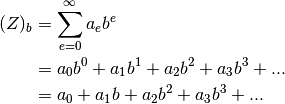16. Appendix¶
You really don’t know when to stop, do you?
16.1. Basic algebra¶
Let’s introduce some number theory. Any number can be represented by the following term:

Now, that was very abstract. Let’s explain first, then make some examples.
The first thing you need to know is the numbers sign  . It’s just a shorthand notation for a sum of many terms. The terms can use a sum variable
. It’s just a shorthand notation for a sum of many terms. The terms can use a sum variable  which starts from an initial value
which starts from an initial value  and goes to some maximum value
and goes to some maximum value  . So
. So  .
.
We also use two exponential laws, namely

Let’s make an example with base  .
.

Let’s now write the same number in the binary system.

Since we’re dealing with computers, here’s an example with base  . Let’s write the number 42 in binary.
. Let’s write the number 42 in binary.
